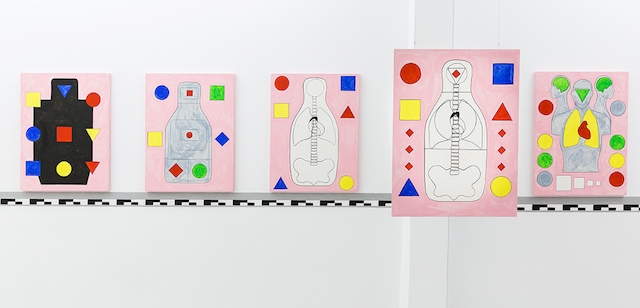When I visited Navine G. Khan-Dossos’s studio in Athens last year she showed me a suite of paintings in which brightly coloured geometric forms are arranged against a hot pink wash. The flesh tone, she told me, is that which signifies that sex is for sale in the city, while the symbols were abstracted from the bodies on shooting targets. The combination drew attention to the forced arrest and HIV-testing of female sex workers by the Greek authorities in 2012, and the imprisonment – on charges of grievous bodily harm – of those who returned positive results.
The work changed the way I read a foreign city – suddenly full of pink doorways and saturated by state violence – while at the same time reminding me how ignorant I was of its codes. Like much of Khan-Dossos’s work, these paintings also portrayed individuals denied a voice without presuming the right to tell their story directly. To do so she draws on the nonfigurative traditions of Islamic art – which represents the unrepresentable through analogy with geometry – and the visual display of that digital information which underpins new modes of communication.
Those new modes of communication – in the form of social media and unregulated journalism – promulgate the stereotypes that her work challenges. Take for example Echo Chamber (2017), painted by the artist onto a long concave wall at Eindhoven’s Van Abbemuseum. Resembling an abstract Islamic design, the mural functions as a portrait of Samantha or Sherafiyah Lewthwaite, dubbed ‘the White Widow’ after her husband’s participation in the 2005 attacks in London and her later conviction on terror offences. The work encodes its subject in a visual language, the hybrid complexity of which contradicts this woman’s crude representation by the mass media. It’s less troubling, the work suggests, unambiguously to ‘other’ those whose actions we don’t understand.
That works such as Scenes from a Pre-Crime (Performance for Security Guards) (2018) are not easily decoded strikes me as the source of their power. This resistance of the urge to simplify, transcribe or make straightforwardly legible the experience of others is particularly important when artists are torn between the urge to offer a voice to those denied one and knowing that to do so could be read as exploitative. That it’s a risky strategy is acknowledged by the decision of this white British artist to change her name to an undecipherable amalgam of names suggesting different geographies, and her work is a reminder that any sincere expression of solidarity across borders, of whatever kind, is precarious and laborious. That Khan-Dossos is willing to take those risks is admirable.
Navine G. Khan-Dossos is a visual artist working between London and Athens. She has exhibited and worked with institutions including salt Beyoğlu, Istanbul; Istanbul Design Biennial; Talbot Rice Gallery, Edinburgh; Van Abbemuseum, Eindhoven; A. M. Qattan Founda- tion, Ramallah; the Museum of Islamic Art, Doha; Witte de With, Rotterdam; Delfina Foundation, London; and the State of Concept, Athens. Shoot the Women First opens on 9 February at Z33, Hasselt.
Ben Eastham is Associate Editor at ArtReview
From the January and February 2019 issue of ArtReview, in association with K11 Art Foundation
